Register now to gain access to all of our features. Once registered and logged in, you will be able to create topics, post replies to existing threads, give reputation to your fellow members, get your own private messenger, post status updates, manage your profile and so much more. If you already have an account, login here - otherwise create an account for free today!
Timing in Call of Cthulhu LCG. Part 2 – Triggered effects
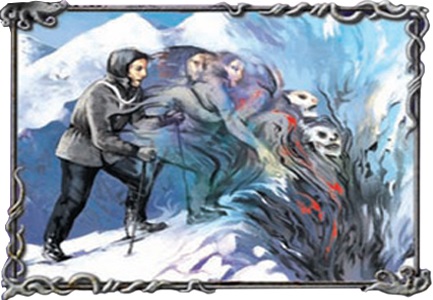 Hello everyone, and welcome to my second article about timing in CoC. The first one was the basic introduction. Sorry for the long delay, but due to an unexpectede event and me being pretty busy I couldn't publish part 2 earlier.
Hello everyone, and welcome to my second article about timing in CoC. The first one was the basic introduction. Sorry for the long delay, but due to an unexpectede event and me being pretty busy I couldn't publish part 2 earlier.This issue is dedicated to the subtleties of the timing of triggered effects. It is written for players who have some knowledge of the rules already and want to delve deeper into the timing of CoC. The complexity in a few sections can be quite high sometimes, but I hope you enjoy reading it nonetheless.
A small note for new players to CoC - later on, I'm going really deep into details. Especially the later examples in this article are pretty much hypothetical/theoretical and won't occur in the vast majority of real games. So don't feel overwhelmed, they're just there so that the consequences of the timing rules can be demonstrated easily!
Targets and affected cards
Before I explore the timing structure in more detail, I'd like to add some info that I forgot to include in the last article. I talked about Interstellar Migration (TkatG) requiring a Yithian character as a valid target to initiate, but did not explain what a target is.
In CoC, an effect is a targeted effect if it contains the special word "choose" to select objects in the game. Shotgun Blast (Core) is a targeted effect for example. To the contrary, Antarctic Wind (AtMoM) is not targeted. Although you as the player of Antarctic Wind may select the character that is going to get the wound(s) and therefore feels like a targeted effect, that character is just an affected card and not a target of Antarctic Wind.
This distinction might seem subtle and not important at first, but there can be consequences. I already told you one in the last article: There need to be sufficient legible targets for an effect to initiate. For example Small Price to Pay (Core) may not be played if you don't control a character, even if your opponent does control one.
Another consequence can be seen with card effects specifically referring to targeting effects. E.g. Professor Zeus (LR) can't be wounded by Shotgun Blast but he may be wounded by Antarctic Wind.
The timing structure
Ok, let's examine the timing structure! The general outline when multiple conditions are met simultaneously is given on p. 11 of FAQ 3.2 (printer friendly version):
1. Disrupt effects
2. Passive effects
3. Forced Response effects
4. (Response effects)
This general outline is very important, you should memorize it. Perhaps you noticed the braces around "Response effects" – I will explain it later, forget it right now.
In the FAQ a more elaborate version of the Action window timing structure follows the general outline on p. 11 and 12:
1. Action is initiated.
a ) Determine the cost (to either play the card or pay for the card's effect) or costs (if multiple costs are necessary for the intended action).
b ) Check play restrictions, including verification and designation of applicable targets or cards to be effected.
c ) Apply any penalties to the cost(s).
d ) Apply any other active modifiers (including reducers) to the cost(s).
e ) Pay the cost(s).
f ) Play the card, or trigger the effect, and proceed to step two.
2. Disrupts
3. Action is executed.
4. Passive abilities are initiated. For each passive ability:
I. Passive ability is initiated.
II. Disrupts
III. Passive ability is executed.
IV. Passive abilities (due to occurrences in steps I to III) are initiated and resolved.
V. Forced Responses (due to occurrences in steps I to IV).
5. Forced Responses are initiated. For each:
I. Forced Response is initiated.
II. Disrupts
III. Forced Response is executed.
IV. Passive abilities (due to occurrences in steps I to III) are initiated and resolved.
V. Forced Responses (due to occurrences in steps I to IV).
6. Responses. For each:
I. Response is initiated.
II. Disrupts
III. Response is executed.
IV. Passive abilities (due to occurrences in steps I to III) are initiated and resolved.
V. Forced Responses (due to occurrences in steps I to IV).
7. End of Action.
That list seems pretty long and complicated at first. But I can assure you that it is very useful. Most of the timing problems in CoC can be solved with it.
Ok, such a list needs some explanation! As you read through it, you recognize that the steps 1 to 7 are the same steps you already know from article 1, "Basic Introduction". What's new are the sub-steps for each step. They are indented here as well as in the FAQ. For example the initiation of the Action, step 1, is structured into sub-step a) to sub-step f). The Responses step, step number 6, features sub-steps I to V. And so on.
When you look at steps 4, 5 and 6, you can see that they are very similar and their sub-steps repeat. They share some identical sub-steps: II (Disrupts), IV (passives) and V (Forced Responses). Step I and III are not 100% identical, but very similar: I is the Initiation, III the resolution of the effect in question.
The reason for this repetition is that the elaborate version of the timing structure is just the general outline applied to an Action plus the general outline is nested in each step of the timing structure, creating the repetition. This will become more clear later, but at first I want to give you the following example. It features two Disrupts which are resolved in completely different (sub-)steps of the Action window:
Player A (let's call her Amanda from now on, that sounds much friendlier) is the inactive player and has Femme Fatale and Educated Officer ready to defend at a story. She's also got Atwood Science Hall in play, resulting in the Officer having a skill of 3:
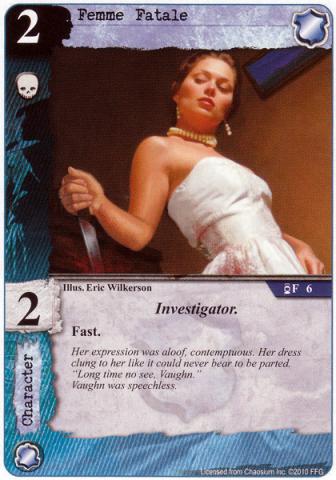
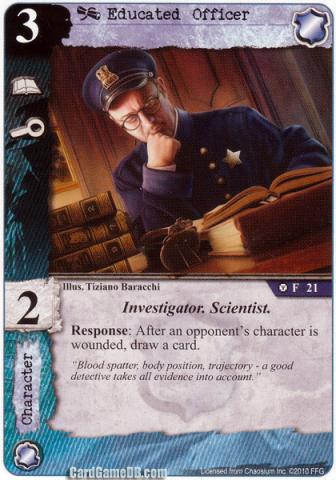
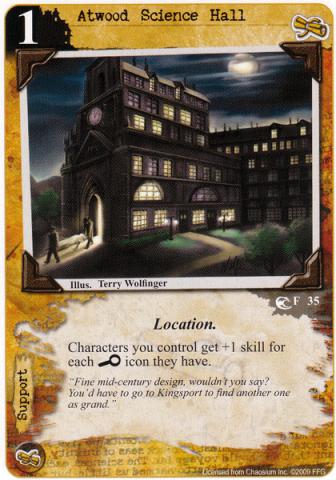
Billy, her opponent, has Ya-te-veo (TUP) in play and already committed it to a story. Ya-te-veo is exhausted because of that. Billy's plan is to use Ya-te-veo's ability to wound Femme Fatal and drive the Educated Officer insane as the result of the Terror struggle in case Amanda commits both. What he does not know is that Amanda has Cover Me! (WoP) and Arcane Translation (SftSK) in her hand. Amanda commits both characters to defend and therefore exhausts them. Billy wants to trigger Ya-te-veo's Action.
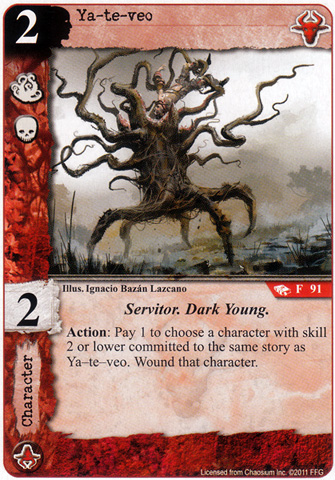
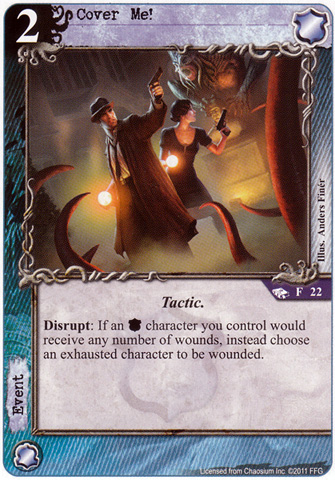
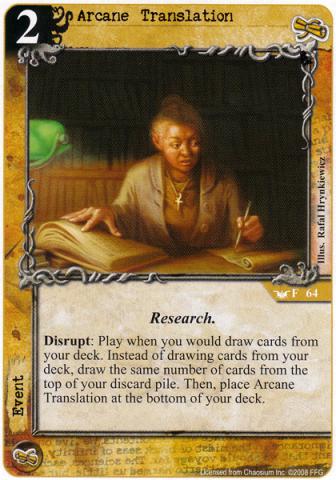
The question is: In what order are all those effects resolved?
Everything starts with Ya-te-veo (TUP)'s Action. Why? Because Actions are the fundamental building blocks of the game and don't interleave.
In step 1 of the Action window timing structure, Billy chooses Femme Fatale (SoA) as the target in 1b ), pays 1 for the effect in 1e ) and triggers the effect in 1f ).
1. Action is initiated.
a ) Determine the cost: A domain with at least 1 resource must be drained.
b ) Check play restrictions, including verification and designation of applicable targets or cards to be effected: Femme Fatale is chosen as the target.
c ) Apply any penalties to the cost(s). Nothing here.
d ) Apply any other active modifiers (including reducers) to the cost(s). Again nothing.
e ) Pay the cost(s): Billy drains the domain.
f ) Play the card, or trigger the effect, and proceed to step two: Billy triggers Ya-te-veo's effect.
Now there's the Disrupt step (number 2). Amanda has two Disrupts, but only the condition of Cover Me! (WoP) is met because we know that Femme Fatale will receive 1 wound through Ya-te-veo. Amanda chooses Ya-te-veo as the target, pays 2 for Cover Me! and plays the card. Cover Me! uses the special word "instead", indicating a replacement effect. Replacement effects do just what their name suggests: They replace one effect with another. In this case, the wounding of Femme Fatale is replaced by the wounding of Ya-te-veo.
1. Action is initiated.
2. Disrupts.
3. Action is executed.
4. Passive abilities.
5. Forced Responses.
6. Responses. For each:
I. Response is initiated.
II. Disrupts
III. Response is executed.
IV. Passive abilities (due to I to III)
V. Forced Responses (due to I to IV)
7. End of Action
In step 3, the Action of Ya-te-veo is resolved. Because Amanda replaced it, the replacement effect is resolved and Ya-te-veo receives the wound which destroys it.
Note that the replacement effect hadn't been resolved in step 2, as one might be tempted to think. It is resolved instead of the replaced effect exactly at the point in the timing structure where the replaced effect would have been. The replacement effect doesn't do something "on its own" in the Disrupt step.
1. Action is initiated.
2. Disrupts.
3. Action is executed.
4. Passive abilities.
5. Forced Responses.
6. Responses. For each:
I. Response is initiated.
II. Disrupts
III. Response is executed.
IV. Passive abilities (due to I to III)
V. Forced Responses (due to I to IV)
7. End of Action
There are no passives or Forced Responses involved, so we can jump to step 6, Responses. An opponent's character had been wounded in step 3 satisfying the trigger condition for Educated Officer (PT). Amanda initiates the Response in 6.I, paying no cost. In 6.II she pays and triggers Arcane Translation (SftSK), disrupting her own Response. Arcane Translation replaces drawing from the deck with drawing from the discard pile. In 6.III, Amanda draws Cover Me! from the discard pile and places Arcane Translation on the bottom of the draw deck.
1. Action is initiated.
2. Disrupts.
3. Action is executed. 4. Passive abilities.
5. Forced Responses.
6. Responses. For each:
I. Response is initiated.
II. Disrupts
III. Response is executed.
IV. Passive abilities (due to I to III)
V. Forced Responses (due to I to IV)
7. End of Action
You can see that although the two event cards share the same kind of effect (Disrupt), they are not resolved in the same place in the timing structure. The proper place is determined by the trigger condition on the Disrupt effect.
Overall, this defense went very well for Amanda – she knocked out a dangerous character of her opponent, and she even got a success token due to the Investigation icon on Educated Officer. Plus Billy knows that she has Cover Me! in her hand, which will make him think twice about winning Combat struggles.
A small side-note for new players: CoC might seem overly predefined and calculation-burden, because you think you can count the icons and know if you should commit or shouldn't. But nothing is set just by the icons. Unexpected events play a big role in CoC and make you double-guess your decisions, resulting in an interesting and exciting gameplay.
Ok, to sum it up:
- The timing structure defines the temporal sequence of the steps of the Action window. The sub-steps in it are nested and follow the general outline: Initiation – Disrupts – Resolution – Passives – Forced Responses.
- Just because two cards have the same trigger (e.g. Disrupt) doesn't mean that they are played shortly after each other. They can be in different steps or sub-steps.
- The word "instead" indicates a replacement effect. The replacement effect is not resolved immediately, but in the step or sub-step where the replaced effect would have resolved.
Why does the initiation show so much sub-steps? Because such a fine granularity is necessary for the proper resolution of effects. I want to give you another example. Just one card this time: Feed Her Young (WaB). It is useful for resource acceleration. The text seems easy to understand: Attach it to a drained domain and draw a card, if you can pay 1 and have 3 Shub resources in general. At first I thought "Great. At the start of a game, I let my opponent go first, then I'll play that event on his 1st turn because it costs 1 (that's easy) and requires a drained domain (that's satisfied through its own cost). Then I refresh the domains on my own 1st turn and will have 3-1-1 resources and shoot out a 3-cost character in turn 1! Wow!" Right? No, wrong!
To understand this, you need to know that targets and affected cards are chosen and determined before costs are paid. Recall sub-steps b ) and e) of the initiation:
a ) Determine the cost (to either play the card or pay for the card's effect) or costs (if multiple costs are necessary for the intended action).
b ) Check play restrictions, including verification and designation of applicable targets or cards to be effected.
c ) Apply any penalties to the cost(s).
d ) Apply any other active modifiers (including reducers) to the cost(s).
e ) Pay the cost(s).
f ) Play the card, or trigger the effect, and proceed to step two.
Feed Her Young (WaB) will be attached to a domain. This domain is selected in sub-step b ) of the initiation. Feed Her Young states that the domain has to be drained. But the cost of Feed Her Young (draining 1 domain with a Shub resource) hasn't been paid yet. It is paid in sub-step e ) of the initiation. Because the selection of affected cards comes before the payment of costs, the domain I use to pay for this card can't be the domain it is going to be attached to! This means that I need to have another 1-cost or 0-cost event in my starting hand to pull off this trick; or that I have to resource regularly up to 2-1-1, play a character draining the 2-domain and only after that I can ramp the drained domain up to 3 resources. But this will benefit me only in the following turn.
You should always keep in mind that sequence of 1b ) and 1e ). In addition, note that the phrase "do X to do Y" is a special phrase in CoC. It means that X is a cost. If Y consists of several things, including a selection, that selection takes place before the cost is paid. I know that the flow of the language seems to indicate that you do X first and then you do Y, but selections and targeting happen before X.
Example:Hamu XX 15:14 (SoK). First you choose the 2 target cards in 6.I.b ). Hamu is not in the discard pile yet! Then you pay the cost of discarding Hamu in 6.I.e). In 6.III, you resolve the effect and add the chosen cards to your hand. This is why Hamu XX 15:14 cannot recur itself.
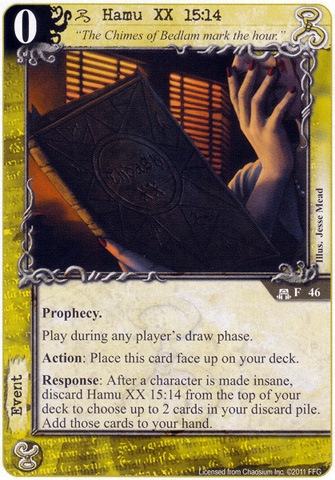
When talking about targets and cards to be affected, there's something else to know: Drawing is considered untargeted. Drawing is the act of putting the top card of the draw deck into your hand. (You can also read the FAQ entry on p. 17 about Alyssa Graham (ER) now, if you like.) "Top card" of something is not targeted and is also not considered to affect the card that is drawn. This means that the card which will be drawn is not determined and fixed in step 1b ) ! If you are familiar to software development, think of the term "top of X" as a pointer.
One consequence of this is, that a card discarded due to Alyssa Graham's Disrupt does not result in the player drawing "void" (e.g. not drawing a card at all). Instead, Alyssa Graham discards the top card, the drawing process continues and then the player draws the (new) top card of his draw deck.
Here's another example, featuring one of my favorite cards in the game: The Cthulhu prophecy Por XV 14:19 (SoK) "drowned upon the altar". In contrast to Hamu XX 15:14, the Cthulhu prophecy will attach itself as a resource to a domain, because it refers to the top of the discard pile like a pointer.
The reason is that the top 2 discarded cards are attached in step 6.III. But at this time the prophecy is already in the discard pile, since it had been discarded earlier to pay its cost in step 6.I.e )
To summarize:
- Selecting targets and determining affected cards takes place before the payment of costs.
- Take care with "do X to do Y" – if Y includes selecting game objects, that part of Y comes before X.
- In contrast to that, "Top of X" (including drawing a card) behaves like a pointer and the referenced card is not determined in step 1b ) of the initiation.
In the first article I told you that CoC doesn't use a stack but a timing structure. Well, that's not correct.
The general outline (Initiation – Disrupts – Resolution – Passives – Forced Responses) is nested in each step of the timing structure, including sub-steps. One result of this is that a Disrupt can disrupt another Disrupt, showing a stack-like behavior. This is possible for example with a Power Drain (Core) being cancelled by a Writhing Wall (SoA).
To convince you of the nested behavior of Disrupts in particular, here is the corresponding quote from the FAQ:
Disrupt effects can be played immediately, whenever their play requirement is met, and their resolution precedes the resolution of the occurrence that allowed the disrupt to be triggered.
Step 2 of the timing structure I gave you is not complete (as well as the FAQ version of the timing structure is not complete, as you might have noticed). It should read like this:
2. Disrupts. For each:
I. Initiation of the Disrupt, with sub-steps a ) to f )
II. Other Disrupts. For each:
i. Initiation
ii. Other Disrupts. For each:
i. Initiation
ii. Other Disrupts. For each:
... continues infinitely in depth ...
iii. Resolve Disrupt
iv. Passives due to the Disrupt
v. Forced Responses due to Disrupt
iii. Resolve Disrupt
iv. Passives due to the Disrupt
v. Forced Responses due to the Disrupt
III. Resolve Disrupt
IV. Passives due to the Disrupt
V. Forced Responses due to the Disrupt
I omitted other sub-steps. For example 2.IV also has sub-steps 2.IV.i (initiation of the passive) to 2.IV.v (Forced Responses to the passive).
I hope you can see the nesting behavior clearly now.
The complete list of the Action Window timing structure can be arbitrarily deep, depending only on the level of sub-sub-…-steps where you want to make the cut. Except for the Disrupt step (which is printed without any sub-steps at all) FFG did make the cut after the first level of sub-steps in their FAQ.
How can you memorize an arbitrarily deep timing structure? You don't need to. Just keep the general outline in mind:
- Initiation
- Disrupt effects
- Resolution
- Passive effects
- Forced Response effects
If you apply this outline accordingly, you can "unfold" the proper structure all the time. Here are the rules for applying it:
- Disrupts may disrupt anything they trigger on. Their resolution precedes the resolution of the disrupted effect. Disrupts show a nesting behavior.
- Passives and Forced Responses are game effects and assert themselves as soon as their condition is met. From the FAQ:
Forced Response effects should always trigger immediately, whenever the circumstances of their text would indicate. These are not player effects, but game effects resolved by the controlling player.
Passive abilities are "always on," and active whenever the circumstances of their text would indicate.
Therefore passives and Forced Responses show a nesting behavior, too. - Responses have a separate, fixed slot where they resolve: step number 6 in the Action window. They are not nesting:
When the requirements (or "play restrictions") for playing a response are met, the response is said to have an "opportunity." […] You can think of opportunities as "gates" that open up, allowing you to play specific responses during an action window. These opportunities (or "gates") can be acted on during Step 6 and stay open until Step 7, when the action finally ends and the action window closes.
All Responses have to wait until step 6 of the Action window. This is the reason why I wrote Response effects in braces in the general outline in the beginning. It is also the reason why steps 4, 5 and 6 of the Action window have sub-steps for Disrupts, passives and Forced Responses, but none of them (even not step 6 itself!) has a sub-step for Responses. Responses can trigger onto anything that occurred in the current Action window, but they must be resolved in step 6 of the Action window and not earlier and not in any sub-step.
Although it is not specifically mentioned in step 1e ), it is also possible to disrupt costs, since Disrupts can disrupt anything they state. Again you can see nesting.
Example: You have a MU character, Infirmary (WoP), and Horrific Light (NN) in hand. In 1e ), you pay the cost of 3 and place 1 wound on the MU character. Supposing that the MU character doesn't have Toughness, the wound would usually lead to the destruction of the character, which would result in the character being placed in the discard pile. But you disrupt the destruction with Infirmary and replace the "destroy" with "return to hand". In 1f ) you trigger the effect of Horrific Light and in step 3 you destroy an opponent's character.
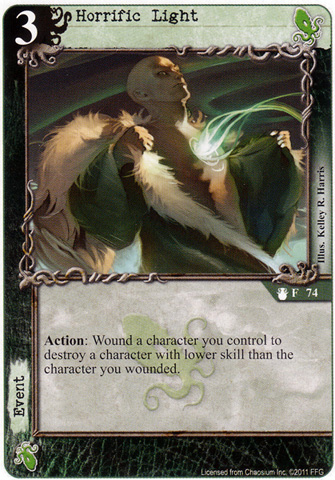
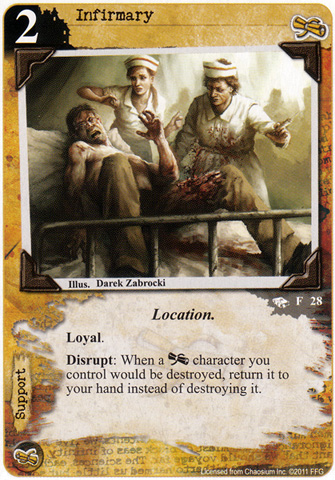
The previous example is one of the rare cases where disrupting in 1e ) doesn't lead to the cost being not paid. Usually, the cost is cancelled or is replaced by something different, and therefore is considered not to be paid. For example if you wanted to wound a high-skilled character for Horrific Light and use Agency Medic (SoA) to sacrifice the Medic instead of the high-skilled character, Horrific Light's effect will not resolve since the cost for it hasn't been paid.
The difference between the two examples is that the Agency Medic cancels the wound which is the cost; but Infirmary replaces only a result of the wound but the cost itself is still paid.
The term "Then"
Some triggered effects include the word "Then". It has a special meaning in CoC: It separates two sub-effects. But the second part of the effect is conditional and is only resolved if the first had been resolved successfully.
The timing of the sub-effects follows this order, too: First, the first sub-effect is resolved. After that and only if the first effect had been successful, the second sub-effect is resolved. (If this weren't the case but both sub-effects were following steps 1 through 3 of the timing structure simultaneously/in parallel, you'd run into trouble with the card Horrid Dreams (SotD): Because targets are chosen before the effect of an Action is resolved, your opponent would have to choose a character before his deck's top card is discarded – but from which faction? The only reasonable way is to follow the general outline of timing for each sub-effect individually/in series.)
Therefore those sub-effects need to have their own initiation, disrupt and resolution segments. Here is an example. Amanda has a high-cost character and Agency Medic in play, and Sacrificial Offerings (Core) in hand. Billy has just a single character in play. Amanda wants to destroy Billy's only character with Sacrificial Offerings, and of course wants to protect her good character with the cheap Medic.
What's the proper way to resolve this situation? You need to apply the general outline of timing to both sub-effects, as shown in the following list. (The numbers indicate the steps according to the Action window timing structure)
1. Initiation of the effect and the first sub-effect of Sacrificial Offerings: Amanda chooses Billy's character, pays 1 for the event, and triggers the effect.
2. Disrupts: Any player may disrupt the first sub-effect or the whole effect. In our example, Billy hasn't anything available. (A Power Drain (Core) e.g. could cancel the whole effect of Sacrificial Offerings = both sub-effects.)
3. Resolve first sub-effect: The chosen character is wounded.
4. Passives whose requirements are now met are resolved. Nothing in our example.
5. Forced Responses whose requirements are now met. Again nothing.
1. The first sub-effect had been successful, so we jump to the second sub-effect. First thing is again step 1 initiation, this time of the second sub-effect: Billy chooses Amanda's high-cost character.
2. Disrupts: Amanda sacrifices the Medic, triggers his Disrupt and cancels the wound.
3. Resolution: Nothing happens to Amanda's good character, since the wound has been cancelled.
4. Passives. Nothing.
5. Forced Responses. Nothing.
6. Responses to anything before (steps 1 to 5 of the first sub-effect and steps 1 to 5 of the second sub-effect).
7. Action window is closed.
Replacement effects and "Then"
Previously, the second sub-effect got cancelled. Now we switch things and deal with a situation where the first sub-effect is being affected somehow. You already know what happens if the first sub-effect gets cancelled: The second sub-effect also won't resolve due to "Then". But what about replacement effects?
Example: Amanda has Charles Dexter Ward (KD) in play and plays Small Price to Pay (Core) from hand. The idea is to choose Ward as the target for insanity (and deflecting it upon a character of Billy!) and then wound another character of Billy. That would be a gorgeous combo. But is it possible? And how are the two parts of the event's effect handled?
Is it possible? No, it's not, because the originally targeted card and not another card needs to have the effect resolve on it successfully. Ward replaces making him insane with making another target insane. Therefore the first sub-effect of Small Price to Pay is resolved unsuccessfully and the second sub-effect won't resolve.
How is it resolved? Here's a detailed breakdown of that situation in the Action window timing structure:
1. Initiation of Small Price to Pay and its first sub-effect (making insane):
b ) Amanda chooses both targets (Ward and the first character of Billy), chooses who will be going insane (Ward) and who will receive the wound (Billy's first character).
e ) She pays 1 for the event.
f ) She triggers the card's Action.
2. Disrupts: Amanda disrupts the first sub-effect with Ward's ability:
I. Initiation: In 2.I.b ) she chooses the second character of Billy as the target.
III. Resolution: Amanda replaces "make Ward insane" with "make the newly chosen character insane".
3. Resolve first sub-effect: Instead of making Ward insane, Amanda makes the newly chosen character insane.
4. Passives to insanity. Nothing in our example.
5. Also no Forced Responses to insanity.
1. Initiation of the second sub-effect. Since the originally targeted character (Ward) has not been made insane, the first sub-effect is not considered to have been successful and therefore the wounding of Billy's first character doesn't take place.
2. to 5.: Nothing.
6. No Responses in our example.
7. Action Window closes.
Lasting effects and endurance of effects
Actions are resolved in step 3 of the Action window timing structure. Most Actions have "one-shot"-effects, which just do something and don't have anything enduring over a period of time. But some Actions create a special kind of another effect that is called a lasting effect. A lasting effect endures up to a specific time (or infinitely). To cite the AGoT FAQ:
Most effects in A Game of Thrones resolve immediately after being triggered, but some effects last for a set period of time, or even indefinitely. Effects that last for longer than a single action are considered lasting effects. Both actions and passive abilities can be lasting effects.
One example is Binding (Core). It creates a lasting effect that erases the printed icons of a character. This effect lasts until the end of the phase. Shadowed Reef (Core) has a lasting effect that goes on indefinitely (and gives each Deep One character a Terror icon). A little bit more complicated example is Intervention (TSC). Its Action does two things: First, it puts itself into play as a character with some icons as indicated on the card (a "one-shot"-effect). Second, a lasting effect is created which is resolved at the end of the phase and leads to the sacrifice of Intervention.
After a lasting effect is created, it doesn't vanish just because the card of its origin leaves play, since the lasting effect is already there. This is interesting and e.g. allows someone to bring into play by Aziz Chatuluka without having to worry about its "you lose the game" text.
If a lasting effect doesn't specifiy an ending time, the endurance of the effect depends. On supports it's indefinitely (e.g. Shadowed Reef). Triggered effects on event cards usually last until the end of the phase (e.g. Binding). An exception to the latter rule are "Put into play," "Remove from play", and "Take Control" effects. The result of those effects is permanent (e.g. Spawn of the Sleeper (TSotS)).
A word on Action and action
Perhaps you noticed that I strangely write Action with a capital letter all the time. There's a reason for this. When I write Action, I refer to an effect with the bold trigger "Action:", as well as with Response to a "Response:"-effect and so on.
In contrast to that, a player action is something a player does, and is a more general term. E.g. an Action is an action, a Response is an action, paying a cost is an action etc. The Action window timing structure refers to an Action, not an action. (If it were referring to an action, all the ordering of Disrupts/action/Response would be blown away – e.g. if you play a Response due to some Action-event that your opponent just resolved, that Response would have its own action window, resulting in step number 6 of the original Action being completely unused.) Note that FFG's FAQ doesn't distinguish both terms as I do, and uses capital and small letters interchangeably. So you don't know which is meant just by looking at the first letter.
Who has the first opportunity to take an Action? And who's got it in case of an action?
In any white box in the turn structure of CoC (Core set rulebook, p. 13), the active player has the first opportunity to trigger an Action. After that, players alternate taking an Action (or pass), until both players subsequently pass.
The active player has the first opportunity to trigger an action after framework effects, too. Example: Amanda lost a Terror struggle and selected Dr. Henshaw (SotM) as the one who will go insane (that's a framework effect). She would like to trigger Henshaw's Disrupt in order to ready a lot of her Agency characters. Billy has Underground Asylum (TSotS) in play and also wants to trigger its Disrupt. Both players want their Disrupt to be triggered first, of course. How is this resolved? It depends. If it's Amanda's turn she takes the first opportunity and uses Henshaw's Disrupt, rendering Underground Asylum useless. If it's Billy's turn, he's got the first opportunity and uses Underground Asylum, making the triggering condition for Henshaw's Disrupt unreachable (since Henshaw would not go insane after Underground Asylum having been resolved).
In contrast to that, if a player uses an action, his opponent has the first opportunity to react to it with another action. Example: Amanda plays Azathoth (SoA) (which features a very intimidating Response). Billy has Lookout (LR) in play and ready, which could blank Azathoth's text box and therefore blank the Response. Again, both players want to trigger "their" Response first. In this case Billy has the first opportunity (since he reacts to an action of Amanda: she played Azathoth), blanks its text box and Amanda can't trigger Azathoth's Response, because it isn't there anymore. At the end of the turn, Azothoth's text box is back again and Amanda has a real problem. Don't summon what ye can't put down!
Important sequences
So what are the important things to memorize? There are just three of them. Here they are again:
Action window:
1. Action window starts with the Action initiation
2. Disrupt effects
3. Resolve Action
4. Passive effects
5. Forced Response effects
6. Response effects
7. Action window closes
General outline (nested for each effect in the Action window):
I. Initiation
II. Disrupt effects
III. Resolution
IV. Passive effects
V. Forced Response effects
Initiation of an effect:
a ) Determine the cost (to either play the card or pay for the card's effect) or costs (if multiple costs are necessary for the intended action).
b ) Check play restrictions, including verification and designation of applicable targets or cards to be effected.
c ) Apply any penalties to the cost(s).
d ) Apply any other active modifiers (including reducers) to the cost(s).
e ) Pay the cost(s).
f ) Play the card, or trigger the effect, and proceed to step two.
With those three sequences in mind, I'm confident that you are able to solve most problems regarding triggered effects in CoC.
That's the end of my second article. I hope I could shed some light onto the timing of CoC. Thanks for reading and stay tuned for the next article about the timing of passive effects! (Please be patient
- Danigral, Midian, Jhaelen and 6 others like this



 Sign In
Sign In Create Account
Create Account











12 Comments
There is just one thing I found a bit confusing, regarding Lasting Effects (which may be caused by English not being my native language): You state Shadowed Reef as an example for a card with a lasting effect of indefinite duration.
'Indefinite' can have several related meanings. One meaning is 'open-ended', another is 'undefined'.
In conjunction with the previous statement, that 'After a lasting effect is created, it doesn't vanish just because the card of its origin leaves play', if you go with the former (wrong) meaning, it would cause Deep One characters to retain the granted Terror icon even after Shadowed Reef leaves play. If you go with the latter (correct) meaning, the granted Terror icon immediately goes away when Shadowed Reef leaves play.
It's more like 'after a lasting effect is created, it will last for its stated duration, even if its origin leaves play'. Exceptions are, as you correctly pointed out, Events (default duration: end of phase) and Control-related effects (default duration: permanent).
So, an indefinite default duration is basically equivalent to 'until it leaves play'.
I'm not sure why, but the story phase is still an ongoing 'struggle' for many players, including myself. Timing, reactions, story effects, etc . . . during the phase is difficult to put together for a new player. I think the biggest challenge is the idea that the reactions to wounds, insanity, and the rest having to wait for 3 (or 4, with a conspiracy) stories to resolve feels unusual.
A detailed, and example-ridden, writeup on the Story phase would be awesome.
An example: Amanda has a Hired Muscle committed to story A unopposed, and a Hired Muschle committed to story B, opposed by Billy's Young Deep One. Billy also has Shadowed Reef.
Amanda resolves the unopposed story first. After this she plans to play Political Demonstration to destroy Shadowed Reef, thus removing the terror icon from Young Deep One, allowing him to be wounded by Hired Muscle.
However, responses cannot resolve during story resolution. Thus, the Hired Muscle at story B would go insane, since the Young Deep One still has the terror icon. After both stories resolve, Amanda could then play Political Demonstration (since she won combat by at least two icons at the unopposed story) and destroy Shadowed Reef (albeit too late to keep her second hired muscle sane).
Good explanation of Feed Her Young. I don't think I ever would have caught that nuance.
Hired Muscle (Core)
Young Deep One (Core)
Political Demonstration (Core)
Shadowed Reef (Core)
Except they don't work right now...
@Jhaelen: Yes, by "indefinite" I meant "undefined", not "infinite". I haven't been aware of the different meanings of indefinite, thx!
@HomerJ: That's pretty speculative, but I look at the story resolution as a big framework Action with lots of subeffects (just not conditionally connected, in contrast to the subeffects connected by "then"). So all Responses need to wait until all stories are resolved.
I also find it difficult to not play the Responses immediately. If a lot of stuff happens, it's easy to forget a Response (especially because I have a bad memory). In casual games where chances of a Disrupt or Forced Response during the story phase are small, I just play the Response immediately ;-) although that's wrong of course.
Regarding the example: Jonathan Folkert gave a nice one about the consequences of Responses needing to wait until after all stories have been resolved.
@Jonathan Folkert: You're right, that demands for a clarification. I should have mentioned that behaviour of the story resolution.
The example in the article is meant to happen in the white box (Core rules p. 13): After Billy committed his characters, but before Amanda commits theirs.
At the end of the example ("this defense went very well for Amanda") I jump pretty quickly to the outcome of the story resolution (assuming that nothing else happened) - only then, the Educated Officer grants Amanda a card, as you correctly point out.
Danigral made another point about something that needs a clarification, regarding the section "Action and action": The player order opportunity for Actions is independent of the player order opportunity for e.g. Responses within the Actions.
To further clarify this:
See http://community.fan...e-5#entry942254
In the 'Action and action' section, when discussing who gets the first opportunity, it might be worth mentioning that Forced Responses are game effects and not player effects, which I take to mean that - regardless of who controls that card - the active player gets the first opportunity to respond to a Forced Response.
Interesting. Damon's answers are very understandable regarding the point that Disrupts happen after costs are paid. But this is true only for Disrupts that disrupt the paid effect (which would happen in step 3), not Disrupts that disrupt the cost (which happens in step 1.e).
It's also clear that if a Disrupt explicitly states to disrupt a cost, the golden rule is in effect and the cost may be cancelled.
But the last of his answers you posted is in contradiction to two other answers he gave me:
Generally it's my understanding that disrupts may disrupt anything they state. The only point in the FAQ that I know of which could contain a limitation to playing Disrupts, is that step 1.e.) doesn't explicitly allow Disrupts to be played. But it doesn't explicitly deny it, too.
The two answers Damon gave me make (at least IMO) more sense than the last answer you got, since Disrupts are nesting and therefor could also nest into step 1.e).
Yeah, that's right, it'd have been better to mention that.
Now I'm doubly appreciative of your article, which has helped identify and correct a misunderstanding of mine!
I also submitted a question to Damon. With the same result, of course. Here's my version: